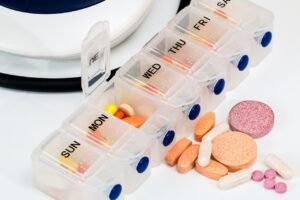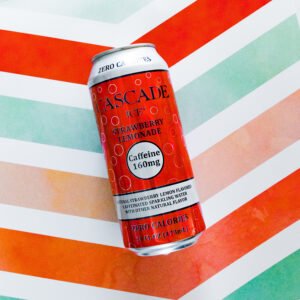by Cascade Ice on October 14, 2025

Most of us consume far too much added sugar, often hidden in seemingly healthy foods. Cutting back doesn’t have to mean sacrificing flavor. Here are 5 impactful ways to dramatically reduce added sugars and boost your health.
Be a Label Detective
Added sugars hide behind dozens of names. Look past the main “Sugar” line and check the ingredients. Watch out for high fructose corn syrup and terms like cane sugar or fruit juice concentrate. The fewer of these ingredients, the better.
Ditch the Sugary Drinks
This is the fastest, most effective change. Sodas, sweetened teas, sports drinks, and many fruit juices are liquid sugar bombs. Instead, swap them for plain water (infuse it with fruit for flavor), unsweetened tea, or black coffee. If plain water is boring, try a sugar-free Cascade Ice Sparkling Water!
Embrace Whole Foods
Processed foods are the main culprits for hidden added sugar. By cooking from scratch with whole, unprocessed ingredients, you control the recipe. Choose fresh or frozen fruits over canned fruit packed in syrup. Buy plain yogurt and sweeten it yourself with berries, not the pre-flavored, sugary tubs.
Rethink Your Sweet Treats
You don’t need to eliminate dessert, just be mindful of your choices and portions. Opt for fresh fruit, a small square of dark chocolate (70% cocoa or higher), or homemade treats where you’ve reduced the sugar by a third. Control your portion size every time.
Use Sugar Substitutes in Moderation
Artificial (like sucralose) and natural (like stevia or monk fruit) sweeteners can help satisfy a craving without adding sugar or calories. Use them strategically – A splash in your coffee or tea, or in reduced-sugar baking. Moderation is key! Don’t rely on them so much that your palate stays trained for intense sweetness. The goal is to gradually wean yourself off the desire for any intense sweetness.
Start with just one or two of these simple swaps today. Your taste buds will quickly adjust, and you’ll find yourself appreciating the natural sweetness in whole foods!
How do you keep your sweets cravings in check? Let us know in the comments below or share a photo! Remember to “like” and “follow” us on Facebook and Instagram.
by Cascade Ice on September 23, 2025

As the weather cools and cold and flu season ramps up, keeping your immune system strong becomes more important than ever. While good nutrition, quality sleep, and stress management are the foundation of health, certain supplements can give your body the extra support it needs to fight off seasonal bugs. Here are five of the best supplements to consider for immune health, along with a simple but often overlooked tip—stay hydrated!
Vitamin C
Vitamin C is one of the most well-known immune-boosting nutrients. It’s a powerful antioxidant that helps protect cells from damage and supports the production of white blood cells, which fight infections. Since your body doesn’t store or produce vitamin C, daily intake is essential. Supplements can fill in gaps, especially during the winter months when fresh fruits and veggies may be less available.
Vitamin D
Often called the “sunshine vitamin,” vitamin D is crucial for regulating immune responses. Low levels of vitamin D are linked to higher susceptibility to infections, particularly respiratory illnesses. Since shorter days and cooler temperatures limit sun exposure, supplementing vitamin D during fall and winter is a smart move for most people.
Zinc
Zinc plays a vital role in immune cell development and communication. It also helps the body heal wounds and fight off invading bacteria and viruses. Research shows that taking zinc at the first signs of illness may reduce the duration of colds, making it an especially useful supplement to keep on hand.
Elderberry
Elderberries have been used for centuries as a natural remedy for colds and flu. Rich in antioxidants and bioflavonoids, elderberry supplements may help reduce the severity and duration of symptoms. Syrups, gummies, and capsules are all popular options for boosting immune resilience.
Probiotics
A healthy guts is directly linked to a strong immune system. Probiotics—beneficial bacteria found in fermented foods and supplements—support gut health and help regulate immune responses. Taking a daily probiotic may improve your body’s ability to defend against seasonal infections.
Don’t Forget: Stay Hydrated
While supplements can give your immune system a valuable boost, one of the simplest and most effective ways to stay healthy is by drinking enough water. Hydration helps flush toxins from the body, keeps mucous membranes moist (making it harder for viruses to take hold), and ensures nutrients are properly transported throughout your system. Aim for at least 8 cups of water a day and consider adding herbal teas or broths for extra warmth and hydration during the colder months. And if regular water just doesn’t compel you to get your water intake up, try a Cascade Ice Sparkling Water!
While supplements certainly aren’t a magic shield against illness, they can provide meaningful support for your immune system when paired with a healthy lifestyle. As always, consult with your healthcare provider before starting new supplements to make sure they’re right for your individual needs. This cold and flu season, a combination of nutrient support, hydration, rest, and mindful habits will help you stay strong and resilient.
What types of supplements do you take to prevent illness? Let us know in the comments below or share a photo! Remember to “like” and “follow” us on Facebook and Instagram.
by Cascade Ice on August 19, 2025

In our busy lives, winding down before bed can often feel like an afterthought. We might scroll through our phones until our eyelids feel heavy or try to squeeze in just one more task before finally collapsing into bed. But a consistent and healthy nighttime routine can be a game-changer for your sleep quality, and in turn, your overall well-being.
Creating a relaxing pre-sleep ritual signals to your body and mind that it’s time to slow down and prepare for rest. It can help reduce stress, improve sleep latency (the time it takes you to fall asleep), and lead to more restful nights. So, let’s dive into the top 5 things you can incorporate into your nighttime routine for a healthier and more rejuvenating sleep:
Power Down Your Devices
This is a big one, but crucial. The blue light emitted from our phones, tablets, and computers can interfere with the production of melatonin, the hormone that regulates sleep. Try to put away your screens at least an hour before bed. Instead of scrolling, pick up a book, listen to calming music, or engage in a relaxing hobby.
Create a Relaxing Ambiance
Set the stage for sleep by making your bedroom a tranquil haven. Dim the lights, ensure the room is a comfortable temperature (typically cooler is better for sleep), and consider using blackout curtains to block out any external light. You can also incorporate calming scents like lavender with a diffuser or a pillow spray.
Wind Down with a Relaxing Activity
Instead of jumping straight from your day’s activities into bed, dedicate some time to unwind. This could involve taking a warm bath or shower, practicing gentle stretching or yoga, meditating, or journaling. Find an activity that helps you feel calm and peaceful.
Hydrate Thoughtfully
While it’s important to stay hydrated throughout the day, be mindful of your fluid intake in the hours leading up to bedtime. Drinking too much right before sleep can lead to disruptive nighttime trips to the bathroom. However, ensuring you are adequately hydrated throughout the day and perhaps sipping a small glass of water, herbal tea, or even a flavored, sugar-free sparkling water like Cascade Ice an hour or two before bed can actually help regulate bodily functions and promote comfort. Avoid drinks with excess sugar or excessive amounts of any liquid close to bedtime.
Stick to a Consistent Schedule
Our bodies thrive on routine. Try to go to bed and wake up around the same time every day, even on weekends. This helps regulate your body’s natural sleep-wake cycle, also known as your circadian rhythm. Consistency can significantly improve the quality and consistency of your sleep over time.
Incorporating these five tips into your nightly routine can make a significant difference in your sleep quality and overall well-being. Experiment with different activities and find what works best for you. Sweet dreams!
What does your nighttime routine look like each night? Let us know in the comments below or share a photo! Remember to “like” and “follow” us on Facebook and Instagram.
by Cascade Ice on June 19, 2025

For many of us, that first sip of coffee or tea is a non-negotiable ritual, a warm, energizing hug that kickstarts the day. Caffeine is a powerful stimulant, offering a temporary boost to focus, alertness, and even mood. But like anything good, too much can lead to some not-so-pleasant side effects. So, how much caffeine is too much? Let’s dive in.
For the average healthy adult, most experts agree that up to 400 milligrams (mg) of caffeine per day is generally considered a safe amount. To put that into perspective:
- An 8-ounce cup of coffee typically contains around 95 mg of caffeine
- A 12-ounce can of soda has about 35 mg
- An 8-ounce cup of green tea contains roughly 28 mg
- An 8-ounce cup of black tea has about 47 mg
This 400 mg guideline is a general recommendation, and individual tolerance can vary significantly based on factors like genetics, body weight, and overall health.
Exceeding your personal caffeine limit can manifest in several ways. If you experience any of the following, it might be a sign to scale back:
- Jitters and restlessness: That shaky, unable-to-sit-still feeling.
- Anxiety and nervousness: Feeling on edge or overly worried.
- Insomnia: Difficulty falling or staying asleep, especially if consumed late in the day.
- Increased heart rate: A noticeable pounding or racing heart.
- Digestive issues: Upset stomach, nausea, or diarrhea.
- Headaches: While caffeine can sometimes alleviate headaches, too much can trigger them or lead to “caffeine withdrawal headaches” if you suddenly stop.
- Irritability: Feeling easily annoyed or short-tempered.
One often-overlooked aspect of caffeine consumption is its diuretic effect, meaning it can increase urine production and potentially lead to fluid loss. This is why staying adequately hydrated is absolutely crucial if you’re consuming caffeine. For every cup of coffee or caffeinated beverage you enjoy, consider reaching for a glass of water shortly after. Dehydration can exacerbate many of the negative side effects of too much caffeine, making you feel even more restless, anxious, or headachy. Make water your constant companion throughout the day. And if regular water isn’t your thing, you can always jazz it up by grabbing a Cascade Ice Sparkling Water – it comes in 17 different flavor combinations so you never get bored! We even offer a caffeinated sparkling water option with the perfect amount of caffeine.
The key to healthy caffeine consumption is listening to your body and finding your personal “sweet spot.” Pay attention to how different amounts affect you. If you’re new to caffeine, start small and gradually increase your intake until you find the amount that gives you the desired boost without any unwanted side effects.
In moderation, caffeine can be a beneficial part of a healthy lifestyle. By understanding the recommended guidelines, recognizing the signs of overconsumption, and prioritizing hydration, you can enjoy your favorite caffeinated beverages without the jitters and truly find your sweet spot.
How much caffeine do you usually drink every day? Let us know in the comments below or share a photo! Remember to “like” and “follow” us on Facebook, Twitter and Instagram.














